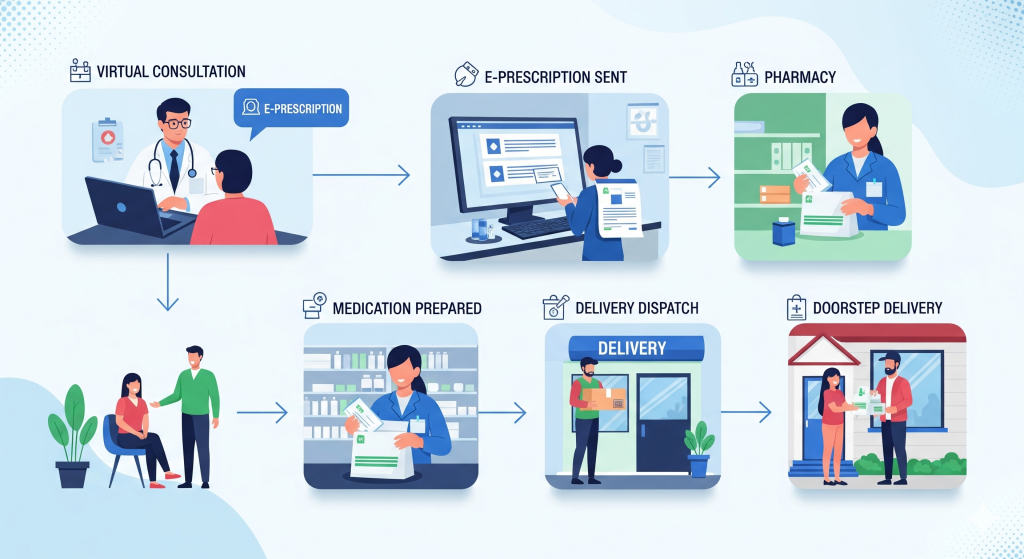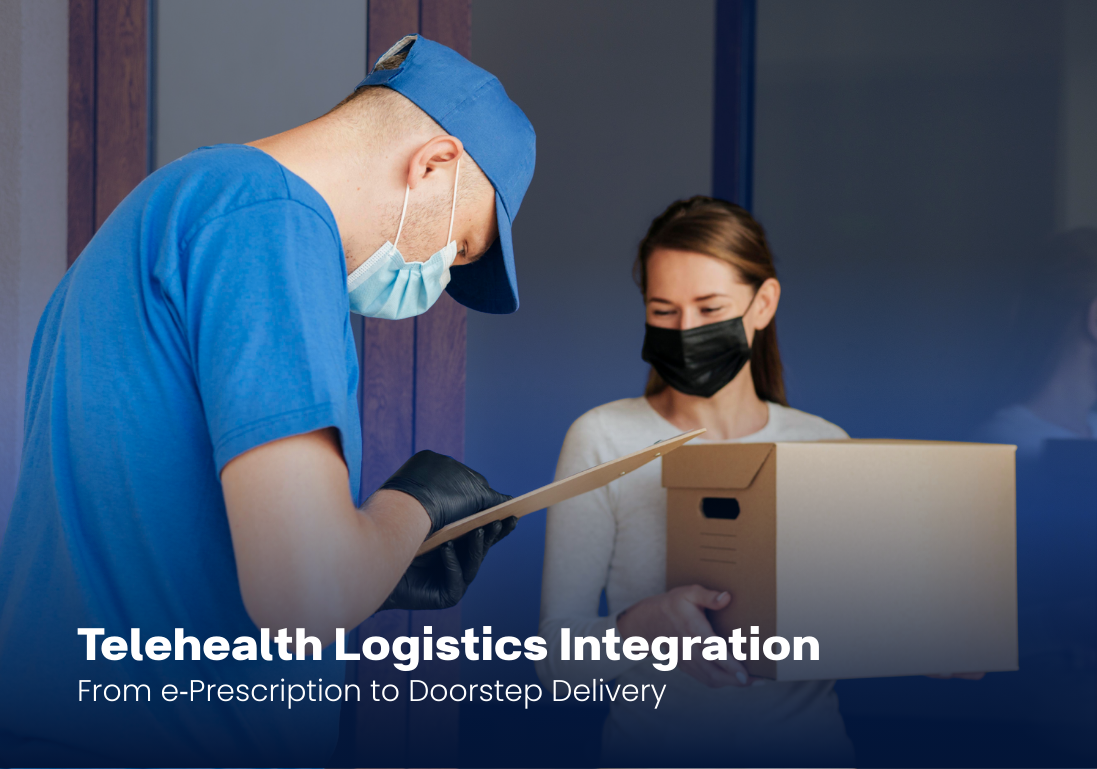Why logistics integration now defines telehealth success
A virtual visit is only meaningful if the patient receives their medication without delay.“In 2025, the success of telehealth depends on the strength of its logistics chain. A seamless experience requires that e-prescriptions flow smoothly through eRx networks, payer approvals happen without delays, pharmacies manage inventory accurately, and medications reach patients within a verified delivery window.” Telehealth logistics integration is no longer a back‑office function it is clinical infrastructure that determines safety, speed to therapy, and adherence.
What telehealth logistics really is?
Telehealth logistics coordinates clinical data, e‑prescribing, benefits adjudication, pharmacy fulfillment, and last‑mile delivery into a single, auditable flow. Done well, it ensures the right drug reaches the right patient with proper documentation, real‑time visibility, and built‑in compliance. The outcome is faster therapy initiation, fewer abandoned prescriptions, and a patient experience that matches modern expectations.
Where the process breaks—and how integration fixes it
Breaks usually occur at handoffs: a prior authorization stalls, a payer rule isn’t recognized, inventory is reserved at the wrong pharmacy, or delivery fails due to poor routing and identity verification. These failures are symptoms of fragmented data. Standards‑based interoperability using FHIR/HL7 for clinical data and National Council for Prescription Drug Programs (NCPDP) SCRIPT for e‑prescribing closes the gaps. With consistent message formats and event feeds, platforms can confirm order receipt, monitor fill status, trigger ePA early, and push delivery milestones back into the EHR in real time.
2025 Architecture: Standards first, orchestration always
The modern pattern centers on a standards‑native backbone. FHIR/HL7 moves medication orders, medication lists, allergies, and status updates across systems; NCPDP SCRIPT handles new prescriptions, changes, cancels, and fills; electronic prior authorization is embedded, so delays are addressed before they grow. On top sits an orchestration layer that ranks pharmacies by inventory, payer fit, delivery capability, and service level agreement. This layer also checks for copay assistance and schedules pharmacist counselling when required. It confirms that the patient can receive it at the chosen time and location.

Real‑time logistics, without the black box
Once a prescription is in motion, visibility matters. Courier integrations expose accurate ETAs, route progress, and proof of delivery with photo or e‑signature. When therapies require temperature control, sensor telemetry and chain‑of‑custody events document that conditions were maintained. Exceptions such as no answer, identity mismatch, weather disruptions, or temperature excursions are routed back to clinicians or pharmacists with clear follow-up actions, ensuring therapy isn’t abandoned.
Compliance that travels with the order
Every step involves protected health information, making HIPAA compliance and robust vendor controls mandatory. Controlled substances introduce extra identity verification and counseling requirements. Storage and handling rules from the FDA and USP apply where relevant, and documentation must be complete enough to pass audits without reconstructing timelines after the fact. The safest systems make audit trails an automatic by‑product of normal operations, not a separate task.
Rethinking the last mile for pharmacy delivery
Pharmacy delivery has shifted to a hybrid of specialty hubs and local micro-fulfillment that shortens transit and improves first‑attempt success. Patients expect evening windows, rescheduling without phone calls, and accurate pricing before they commit. Identity checks can be completed at the door or digitally in advance. For chronic therapies, refills should be proactive and predictable, with counseling available asynchronously or by video.
“At ISCL, we believe telehealth success in 2025 depends on the strength of its logistics chain…”
A practical blueprint you can implement
Start by standardizing your data layer with FHIR/HL7 for clinical events and NCPDP SCRIPT for e‑prescribing. Make electronic prior authorization a default, not an exception. Build an orchestration service that evaluates pharmacies by inventory, payer alignment, distance, cold‑chain capability, and promised delivery windows. Integrate multiple courier partners for redundancy and feed delivery milestones back into the EHR so clinicians see the same truth as operations present patients with honest timelines, real‑time tracking, and easy rescheduling. Protect the entire flow with encryption, role‑based access, and regular vendor audits.
What to measure to prove it works
Measure the time from eRx to delivery, not just time to “ready for pickup.” Track first‑attempt delivery success, prior authorization cycle time, and temperature compliance where applicable. Follow up with medication adherence at 30 and 90 days. These few numbers will tell you if your healthcare logistics integration is actually improving outcomes.
Conclusion
Telehealth’s promise depends on the reliability of its logistics. When eRx fulfillment, FHIR/HL7 interoperability, and pharmacy delivery operate as one system, patients start therapy faster, abandonment falls, and clinicians trust that what they prescribe will arrive. In 2025, integration isn’t an optimization it’s the standard of care.
Join the summit to accelerate your roadmap.
FAQs
- What is telehealth logistics?
It is the coordinated process that moves a medication from virtual prescription to verified delivery, with clinical safety and compliance built in.
- How does eRx fulfill speedy care?
By automating benefit checks, routing to the best‑fit pharmacy, and initiating prior authorization early so that the medication can ship or deliver without avoidable delays.
- Why is FHIR/HL7 integration important?
It provides reliable, standards‑based data exchange across EHRs, pharmacies, and delivery systems, enabling real‑time status and auditable histories.
- How is pharmacy delivery verified?
Through courier telemetry, secure proof of delivery, and chain‑of‑custody records that confirm the right patient received the right therapy.




